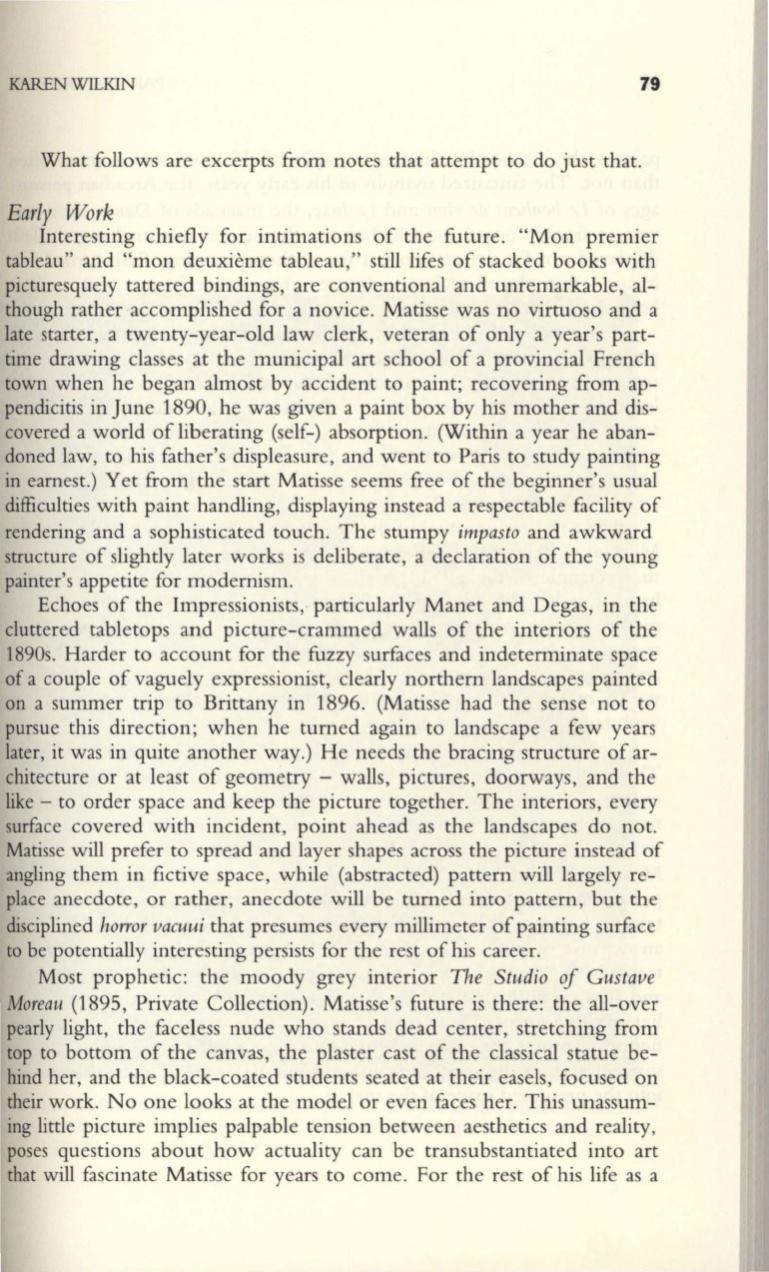
KAREN WILKIN
79
What follows are excerpts from notes that attempt to do just that.
Early Work
Interesting chiefly for intimations of the future. "Mon premier
tableau" and "mon deuxieme tableau," stilllifes of stacked books with
picturesquely tattered bindings, are conventional and unremarkable, al–
though rather accomplished for a novice. Matisse was no virtuoso and a
late starter, a twenty-year-old law clerk, veteran of only a year's part–
time drawing classes at the municipal art school of a provincial French
town when he began almost by accident to paint; recovering from ap–
pendicitis in June 1890, he was given a paint box by his mother and dis–
covered a world of liberating (self-) absorption. (Within a year he aban–
doned law, to his father's displeasure, and went to Paris to study painting
in earnest.) Yet from the start Matisse seems free of the beginner's usual
difficulties with paint handling, displaying instead a respectable facility of
rendering and a sophisticated touch. The stumpy
impasto
and awkward
structure of slightly later works is deliberate, a declaration of the young
painter's appetite for modernism.
Echoes of the Impressionists, particularly Manet and Degas, in the
cluttered tabletops and picture-crammed walls of the interiors of the
1890s. Harder to account for the fuzzy surfaces and indeterminate space
of a couple of vaguely expressionist, clearly northern landscapes painted
on a summer trip to Brittany in 1896. (Matisse had the sense not to
pursue this direction; when he turned again to landscape a few years
later, it was in quite another way.) He needs the bracing structure of ar–
chitecture or at least of geometry - walls, pictures, doorways, and the
like - to order space and keep the picture together. The interiors, every
surface covered with incident, point ahead as the landscapes do not.
Matisse will prefer to spread and layer shapes across the picture instead of
angling them in fictive space, while (abstracted) pattern will largely re–
place anecdote, or rather, anecdote will be turned into pattern, but the
disciplined
ho"or vacuui
that presumes every millimeter of painting surface
to be potentially interesting persists for the rest of his career.
Most prophetic: the moody grey interior
The Studio oj Gustave
Moreau
(1895, Private Collection). Matisse's future is there: the all-over
pearly light, the faceless nude who stands dead center, stretching from
top to bottom of the canvas, the plaster cast of the classical statue be–
hind her, and the black-coated students seated at their easels, focused on
their work. No one looks at the model or even faces her. This unassum–
ing little picture implies palpable tension between aesthetics and reality,
poses questions about how actuality can be transubstantiated into art
that will fascinate Matisse for years to come. For the rest of his life as a


